Wednesday, January 23, 2013
Ideas Unbound - Gatecrash Prerelease Primer - Part 1

Prereleases are always exciting events. Players are getting their hands on the new cards for the first time and really seeing what they can do. Sometimes a card will look powerful in the abstract, but when you actually play with it, it does not live up to expectations. And sometimes, cards you had written off as unplayable will surprise you. I run the prereleases for my local shop, and, this week, I’m going to go over a Prerelease Preparation Guide. I am going to do this in two parts. Today will be about playing sealed deck in general and how it pertains to the prerelease. In the second part, tomorrow, we will look at the five guilds of Gatecrash and some sealed deck strategies specific to each one.
Sealed Deck 101
For those unfamiliar with the format, Sealed Deck is a limited format. That means you have to build the deck you play out of a limited pool of cards. In the case of the prerelease, that pool will consist of six Gatecrash booster packs, one of which will be specific to the Guild you choose. Because of the limited card pool available, it’s important to remember that card evaluations changes. A card you would never consider playing in your Standard deck may be a limited all-star. Let’s look at some of the things that might make a card good in sealed.
Evasion
Almost all limited formats revolve around creatures and combat, because creatures are the most abundant card type in Magic. You are just going to get more creatures than anything else. This can lead to game states where both players have a board full of creatures and its get bogged down in combat math. A creature with an evasion ability is important because it will allow you to get through in combat and break a stalemate.
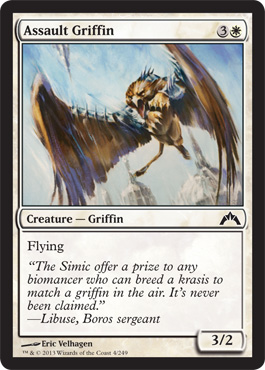 The most common evasion keyword is flying. You will see this a lot in sealed because it is the most common keyword in Magic. When building your deck, look at what creatures you have with flying, and you want to evaluate them a little higher than equivalent creatures without flying. One unanswered flying creature can win the game by itself sometimes.
The most common evasion keyword is flying. You will see this a lot in sealed because it is the most common keyword in Magic. When building your deck, look at what creatures you have with flying, and you want to evaluate them a little higher than equivalent creatures without flying. One unanswered flying creature can win the game by itself sometimes.Flying is not the only form of evasion, though. Some of the creatures in the Dimir Guild are just unblockable. This is better than flying on the offensive because your opponent cannot block with his own flying creatures. This ensures your ability to attack through for damage on a clogged board state. This is especially important when considering cards with Cipher ability, but we will get to that later.
Other creature abilities that can considered “evasion” are first strike and trample. First strike allows you to attack favorably in more situations. In most cases, if your opponent blocks, they will lose their creature and you will not lose yours. This allows you to attack more often with the creature because your opponent is less likely to block it if they are just throwing away their creature. Trample works similarly to this. If your opponent blocks, the trample creature may trade with the blocker but will hopefully deal some damage to your opponent in the process. This will allow you to progress the game state in a way that is profitable to you.
Removal
Removal is one of the most important concepts in limited game play. In Standard, it’s easy to throw four to eight removal spells in your deck, because you have open access to all of them. That is not so in sealed. You can only play the removal spells available in your pool so it’s important to play the ones you get, even if they would be too weak for Standard decks. As mentioned above, limited game play is focused on creatures. Being able to deal with your opponents creatures allows your creatures to gain the advantage.
Just like evasion, removal can come in many forms. Sometimes removal is obvious, but sometimes it can be subtle. The phrase “destroy target creatures” is pretty blatant. Cards that do that are usually very good in limited. However, it’s important to realize there are other ways to deal with creatures. Debtor’s Pulpit is an excellent example of this. While it does not remove a creature from the battlefield it does allow you to keep their best creature tapped. If the creature has no activated or triggered abilities it essentially does not exist anymore.
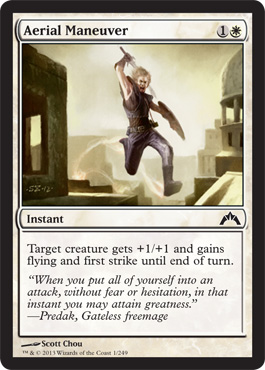
Combat tricks are another less obvious form of removal. Anything that allows your creature to gain an advantage in combat can kill off an opposing creature. Imagine the scenario where your opponent has a 2/2 flier and you have 1/1 ground creature. It would not be unusual for your opponent to attack in this situation because he is almost certainly going to get in for 2 damage. Now imagine the same situation and you have Aerial Maneuver in your hand. When your opponent attacks with that 2/2 flier, Aerial Maneuver might as well read “destroy that creature” because your 1/1 will now be a 2/2 flier with first strike that will take out his attacker. You cannot rely too heavily on combat tricks as straight up removal, though, because it is possible your opponent has their own combat tricks as well.
While removal is generally very good in limited, it is important to remember that too much of a good thing can be a bad thing. You do not want to load up on removal and then have no way to kill your opponent. It’s rare that you would get that much removal in a sealed pool, but it is possible. If that is the case, it is important to find that right balance between removal and creatures. That leads me into my next topic.
Deck Construction
Building a good sealed deck is not easy. You have a lot of options and limited time to evaluate them. It’s made even more difficult in a multicolor focused set like Gatecrash because it is easier to play more of the cards in your pool. There are a few things to keep in mind when building your sealed deck to help make it the best possible.
The deck limit for sealed deck is 40 cards. When building any Magic deck it is rarely a good idea to have more cards than the deck limit. The fewer cards you play, the more likely you are to draw your most powerful cards. It is very rare that I play more than 40 cards in a limited deck or more than 60 cards in a constructed deck. In a typical 40 card sealed deck, you will usually want to play around 17 lands and 23 spells. These numbers are not set in stone, but it is a good a place to start and in my experience it is not usually a good idea to deviate too far from them.
In those 23 spells, you typically want at least half of them to be creatures, or cards that create creatures. Remember that creatures are the most abundant resource you have to win the game. You want to be able to draw enough creatures to have a presence on the board and outlast your opponent’s removal. You also want to make sure you have cards of different converted mana costs with more on the lower end then the high end. If you play all cards that cost 2 or 3, they are going to quickly get outclassed by your opponent. If you play all cards that cost 5 or 6 then you will have to wait too long to play them allowing your opponent an early advantage.
Normally, in sealed deck, choosing which colors to play can be a difficult decision. Fortunately, at the prerelease, Wizards has removed a lot of the guess work for us by providing the Guild booster. It will be rare for you to not play the colors of the guild you choose because one of your boosters only contains cards of those colors. You would have to have some pretty powerful cards in another color combination to choose otherwise. I am not saying it would be impossible, I am just saying it would be rare.
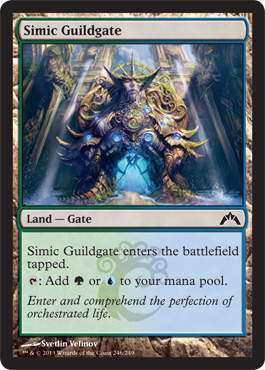
One decision you will have to face is whether or not to add a third (or possibly fourth) color. You would really only want to do this if you have powerful cards in that color and you have enough mana-fixing to support them. There is no reason to put those cards in your deck if you won’t be able to cast them. Mana-fixers like Keyrunes and Guildgates are excellent for allowing you to play off color cards.
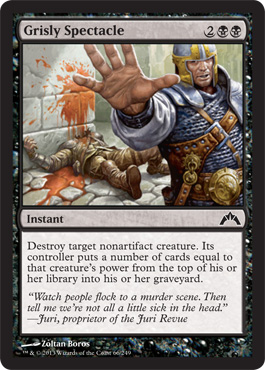 When adding a third color, make sure you have a reason for doing so. If you are playing Boros, it might be a good idea to splash black to play a good Orzhov removal spell. Or maybe you are playing Gruul and you splash blue for some good flying creatures. When choosing a third color you want to look at colors that cross over in your guild. In Boros, you want to look for Green or Black spells from Gruul or Orzhov because you are more likely to have mana fixing for those color combinations. Also, you want to avoid cards in your third color that require more than one mana of that color. Grisly Spectacle is an excellent removal spell, but you don’t want to try adding it to a Simic deck unless you have a lot of blue-black mana fixing.
When adding a third color, make sure you have a reason for doing so. If you are playing Boros, it might be a good idea to splash black to play a good Orzhov removal spell. Or maybe you are playing Gruul and you splash blue for some good flying creatures. When choosing a third color you want to look at colors that cross over in your guild. In Boros, you want to look for Green or Black spells from Gruul or Orzhov because you are more likely to have mana fixing for those color combinations. Also, you want to avoid cards in your third color that require more than one mana of that color. Grisly Spectacle is an excellent removal spell, but you don’t want to try adding it to a Simic deck unless you have a lot of blue-black mana fixing.Wrapping Up
At this point we have gone over a lot of the basics of Sealed deck play and some pointer on this prerelease specifically.
• Evasion is important on your creatures.
• You want to play the removal spells you get, as long as it’s not excessive
• Don’t play more than 40 cards.
• Make sure you have plenty of creatures
• Try to avoid a third color unless you have the mana fixing to support it.
Tomorrow, we will be breaking down the five Guilds individually. We will look at the best strategies for that guild as well as some key cards for each guild that you want to play. We will also look at how to interact against the other guilds as well.
Subscribe to:
Post Comments
(Atom)
Blog Archive
-
▼
2013
(74)
-
▼
January
(14)
- Ideas Unbound - All Saint's Day
- Explore - Press Your Modern Luck
- Thirst for Knowledge - The Modern Banning Effect
- Ideas Unbound - Gatecrash Prerelease Primer - Part 2
- Explore - Walletcrush, err, Gatecrash
- Ideas Unbound - Gatecrash Prerelease Primer - Part 1
- Thirst for Knowledge - Possible Modern Unbans
- Ideas Unbound - First Look at Gatecrash Standard
- Thirst for Knowledge - Hexchantments
- No Arcane Melee Tonight
- Ideas Unbound - The Champ is Here
- Explore - Is That Good ?
- Thirst for Knowledge - RTR Standard Metagame 1/7/13
- New Layout, New Writer and New Schedule
-
▼
January
(14)
# Infected
Archives
-
▼
2013
(74)
-
▼
January
(14)
- Ideas Unbound - All Saint's Day
- Explore - Press Your Modern Luck
- Thirst for Knowledge - The Modern Banning Effect
- Ideas Unbound - Gatecrash Prerelease Primer - Part 2
- Explore - Walletcrush, err, Gatecrash
- Ideas Unbound - Gatecrash Prerelease Primer - Part 1
- Thirst for Knowledge - Possible Modern Unbans
- Ideas Unbound - First Look at Gatecrash Standard
- Thirst for Knowledge - Hexchantments
- No Arcane Melee Tonight
- Ideas Unbound - The Champ is Here
- Explore - Is That Good ?
- Thirst for Knowledge - RTR Standard Metagame 1/7/13
- New Layout, New Writer and New Schedule
-
▼
January
(14)
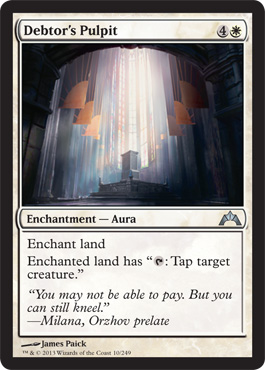
0 comments:
Post a Comment